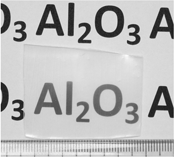Crossref Citations
This article has been cited by the following publications. This list is generated based on data provided by
Crossref.
Kong, Ling Bing
Huang, Yizhong
Que, Wenxiu
Zhang, Tianshu
Li, Sean
Zhang, Jian
Dong, Zhili
and
Tang, Dingyuan
2015.
Transparent Ceramics.
p.
191.
Yang, Yan
Liu, Yin
Shimai, Shunzo
and
Wu, Yiquan
2016.
Green and Sustainable Manufacturing of Advanced Material.
p.
497.
Yin, Jie
Li, Yiyu
and
Wu, Yiquan
2016.
Near-net-shape processed ZnS ceramics by aqueous casting and pressureless sintering.
Ceramics International,
Vol. 42,
Issue. 9,
p.
11504.
Sun, Yi
Peng, Xiang
Shimai, Shunzo
Zhou, Guohong
and
Wang, Shiwei
2016.
Improved Strength of Alumina Ceramic Gel and Green Body Based on Addition‐Esterification Reaction.
International Journal of Applied Ceramic Technology,
Vol. 13,
Issue. 6,
p.
1159.
Dong, Qizheng
Zhu, Tianbin
Xie, Zhipeng
Han, Yao
and
An, Di
2017.
Optimization of the tape casting slurries for high-quality zirconia substrates.
Ceramics International,
Vol. 43,
Issue. 18,
p.
16943.
Luo, Jin
and
Eitel, Richard
2018.
Aqueous tape casting of Al2O3 for multilayer co-fired ceramic based microfluidic chips with translucent windows.
Ceramics International,
Vol. 44,
Issue. 3,
p.
3488.
Ozmen, Ozcan
Ozsoy‐Keskinbora, Cigdem
and
Suvaci, Ender
2018.
Chemical stability of KNbO3, NaNbO3, and K0.5Na0.5NbO3 in aqueous medium.
Journal of the American Ceramic Society,
Vol. 101,
Issue. 3,
p.
1074.
Feng, Zhao
Qi, Jianqi
Han, Yong
and
Lu, Tiecheng
2018.
Deformation restraint of tape-casted transparent alumina ceramic wafers from optimized lamination.
Ceramics International,
Vol. 44,
Issue. 1,
p.
1059.
TAKEUCHI, Makoto
NIEDERMAIER, Matthias
JANSOHN, Monika
UMEHARA, Noritsugu
and
LAINE, Richard M.
2019.
Processing thin (<10 µm), dense, flexible α-Al<sub>2</sub>O<sub>3</sub> films from nanopowders.
Journal of the Ceramic Society of Japan,
Vol. 127,
Issue. 2,
p.
81.
Ayode Otitoju, Tunmise
Ugochukwu Okoye, Patrick
Chen, Guanting
Li, Yang
Onyeka Okoye, Martin
and
Li, Sanxi
2020.
Advanced ceramic components: Materials, fabrication, and applications.
Journal of Industrial and Engineering Chemistry,
Vol. 85,
Issue. ,
p.
34.
Xiao, Zhuohao
Yu, Shijin
Li, Yueming
Ruan, Shuangchen
Kong, Ling Bing
Huang, Qing
Huang, Zhengren
Zhou, Kun
Su, Haibin
Yao, Zhengjun
Que, Wenxiu
Liu, Yin
Zhang, Tianshu
Wang, Jun
Liu, Peng
Shen, Deyuan
Allix, Mathieu
Zhang, Jian
and
Tang, Dingyuan
2020.
Materials development and potential applications of transparent ceramics: A review.
Materials Science and Engineering: R: Reports,
Vol. 139,
Issue. ,
p.
100518.
Feng, Zhao
Qi, Jianqi
and
Lu, Tiecheng
2020.
Highly-transparent AlON ceramic fabricated by tape-casting and pressureless sintering method.
Journal of the European Ceramic Society,
Vol. 40,
Issue. 4,
p.
1168.
Bolek, Paulina
Wu, Yiquan
Yang, Yan
and
Zych, Eugeniusz
2020.
Photo- radio- and thermoluminescence of sintered transparent Al2O3:Eu2+ in the range 15–800 K.
Optical Materials,
Vol. 105,
Issue. ,
p.
109877.
Liu, Weiwei
Li, Maoshan
Nie, Jianbin
Wang, Chuanyang
Li, Wenli
and
Xing, Zhanwen
2020.
Synergy of solid loading and printability of ceramic paste for optimized properties of alumina via stereolithography-based 3D printing.
Journal of Materials Research and Technology,
Vol. 9,
Issue. 5,
p.
11476.
Marsico, Carli A.
Orlicki, Joshua A.
and
Blair, Victoria L.
2020.
Investigation of room‐temperature super‐stabilized suspension casting system mechanism.
Journal of the American Ceramic Society,
Vol. 103,
Issue. 3,
p.
1514.
Trunec, Martin
Kastyl, Jaroslav
Stastny, Premysl
and
Hildebrandt, Stefanie
2021.
Processing of large and complex-shaped fine-grained alumina bodies with high transparency.
Journal of the European Ceramic Society,
Vol. 41,
Issue. 3,
p.
2016.
He, Yu
Cai, Yunxiang
Zhang, Ling
Liu, Kaige
Liu, Gang
Xiang, Bingxi
Zhai, Jianpang
Kong, Ling Bing
Zhang, Tianshu
and
Liu, Yin
2021.
Rapid fabrication of extremely thin Nano-Al2O3 transparent ceramic wafers through nonaqueous tape casting.
Ceramics International,
Vol. 47,
Issue. 21,
p.
30677.
Nie, Jianbin
Li, Maoshan
Liu, Weiwei
Li, Wenli
and
Xing, Zhanwen
2021.
The role of plasticizer in optimizing the rheological behavior of ceramic pastes intended for stereolithography-based additive manufacturing.
Journal of the European Ceramic Society,
Vol. 41,
Issue. 1,
p.
646.
Pabst, Willi
and
Hříbalová, Soňa
2021.
Light scattering models for describing the transmittance of transparent and translucent alumina and zirconia ceramics.
Journal of the European Ceramic Society,
Vol. 41,
Issue. 3,
p.
2058.
Kandavalli, Sumanth Ratna
Kandavalli, Sunanda Ratna
Ruban, Rajesh S.
Lo, Chih Hung
Kumar, Ravinder
Elshalakany, Abou Bakr
and
Pruncu, Catalin I.
2022.
Review—A Conceptual Analysis on Ceramic Materials Used for Dental Practices: Manufacturing Techniques and Microstructure.
ECS Journal of Solid State Science and Technology,
Vol. 11,
Issue. 5,
p.
053005.





